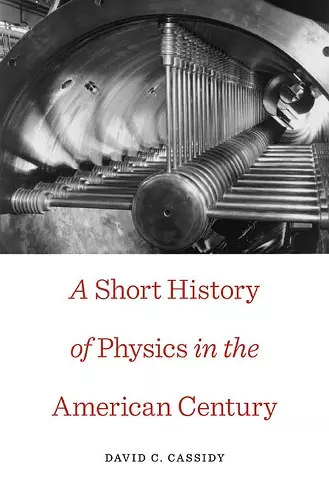A Short History of Physics in the American Century
Format:Paperback
Publisher:Harvard University Press
Published:2nd Sep '13
Currently unavailable, and unfortunately no date known when it will be back

As the twentieth century drew to a close, computers, the Internet, and nanotechnology were central to modern American life. Yet the advances in physics underlying these applications are poorly understood and widely underappreciated by U.S. citizens today. In this concise overview, David C. Cassidy sharpens our perspective on modern physics by viewing this foundational science through the lens of America's engagement with the political events of a tumultuous century.
American physics first stirred in the 1890s-around the time x-rays and radioactivity were discovered in Germany-with the founding of graduate schools on the German model. Yet American research lagged behind the great European laboratories until highly effective domestic policies, together with the exodus of physicists from fascist countries, brought the nation into the first ranks of world research in the 1930s. The creation of the atomic bomb and radar during World War II ensured lavish government support for particle physics, along with computation, solid-state physics, and military communication. These advances facilitated space exploration and led to the global expansion of the Internet.
Well into the 1960s, physicists bolstered the United States' international status, and the nation repaid the favor through massive outlays of federal, military, and philanthropic funding. But gradually America relinquished its postwar commitment to scientific leadership, and the nation found itself struggling to maintain a competitive edge in science education and research. Today, American physicists, relying primarily on industrial funding, must compete with smaller, scrappier nations intent on writing their own brief history of physics in the twenty-first century.
A Short History of Physics in the American Century by David Cassidy presents a brisk but excellent institutional and political history of the discipline, ornamented by lucid descriptions of physics concepts and discoveries… [It] deserves a wide audience, including physicists curious about their discipline’s prominent role in modern U.S. history… A snappy and enjoyable read. -- Benjamin Wilson * Physics Today *
This is a must read for physics students and indeed anyone who wants to understand the development of the American physics enterprise and the interlocking roles of universities, private laboratories, and the federal government. -- A. Spero * Choice *
David Cassidy tells a big story in a short book written for anyone interested in the place of science in American society. American physics began to stir at the end of the 19th century and rose to world hegemony by the beginning of World War II. The creation of the atomic bomb, the Cold War, and the consequent lavish support for physics meant that American dominance endured until the last decades of the 20th century. Cassidy stresses the perennial opposition between pure and applied physics, the gigantizing of science dependent on the federal purse, the transition from powerful science administrators to functionaries, globalization, and the relative marginalization of women. His conclusion on the rise of solid-state physics, computing, and the Internet brings this dramatic story to a dramatic close. -- J. L. Heilbron, author of Galileo
The real history of America in the twentieth century was shaped by the obscure struggles of physicists: from the electrification of the nation, to the nuclear standoff of the Cold War, to the information revolution, the lives of Americans have been affected in fundamental ways by the achievements of the physics community. Cassidy tells this essential story with brevity and style, filling a major gap in modern historiography. -- Spencer Weart, AIP Center for History of Physics
- Nominated for Watson Davis and Helen Miles Davis Prize 2013
- Nominated for Pfizer Award 2012
ISBN: 9780674725829
Dimensions: unknown
Weight: unknown
224 pages